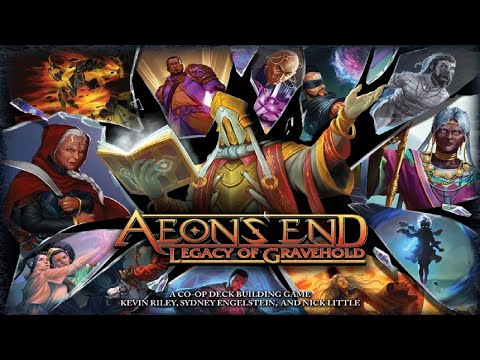
Aeon’s End Legacy incorporates a lot of the fun elements of a casual deck builder game and adds the legacy framework that has grown to be a popular method of republishing successful intellectual property. All of that is fine, but if you do decide to pick up a copy of this at any time, keep in mind that playing through multiple games is the greatest way to enjoy its innovative component.
To purchase additional cards for the deck, you must first earn resources. As the game progresses, your goal is to use the cards with damage associated to beat the “boss” of each level as quickly as possible. Similar to Dominion, which is arguably the most iconic deck builder ever created, there is a limited supply of cards in the middle, each has a price, and some of them provide you the means to purchase more costly cards down the road. You have some control over how you modify or develop this deck, and it changes with every game round (or, in principle, every new game).
What the Game is About
Aeon’s End is a special deck-builder that emulates the last boss fights from vintage video games. A Nemesis, who unleashes a variety of minions and attacks on both the Mages and Gravehold—the city you are defending—takes on one or more so-called Breach Mages. The game’s fourth stand-alone version is called The New Age.

Similar to Aeon’s End, Aeon’s End War Eternal, and Aeon’s End Legacy, The New Age can be played independently or in combination with any additional content that has been made available.
The abundance of options to spend your money (referred to as “aether”), the fact that your deck is never shuffled, and the set yet extremely adjustable market are the hallmarks of Aeon’s End games.
You lose when Gravehold runs out of life or when all of your Mages are used up. You win when the Nemesis is dead or when its deck is empty.
Break Down the Break Down!
I won’t get into the specifics of how the mages operate because reading this review will take several sittings for any reader, let alone someone like myself who has a short attention span. However, I do want to make it clear that every mage is different in several respects, including breach setup, starting hand, starting deck, unique ability, and cost to use said ability.
To maximize the number of spells you can cast in a given round, your breach configuration determines how many spells you can cast and how much aether (money) you must pay during the game to open all of your breaches.
Every mage has a single card that is exclusively their own, which influences their initial few turns and sometimes much more. The remaining cards in the mage’s beginning hand and deck are either Crystals or Sparks, the two basic card types. supplying them with a single spell that deals a single harm or a single aether.

What truly distinguishes a mage from the others is their special ability, which can range from double casting spells to mending mages, curing Gravehold, or bestowing extra turns onto a mage. Charges are required for each unique skill. These can be obtained by playing cards or by using aether that is purchased during the player’s turn. Charges are retained on your player mat until they are used up or the enemy uses an ability that forces you to discard them all, ruining all of your well-laid plans and forcing you to lose the game.
How to Play Aeon’s End?
Don’t expect earth-shattering storytelling, though; the New Age comes with a preconstructed campaign-like approach to playing the game, which is useful for grasping how the Expedition system works. Fortunately, that’s not the reason I play this game; instead, each game tells a different story depending on how well your impromptu deckbuilding aligns with the Nemesis’ progression.
You become more than just a player when you use the Expedition system. That has a slight Magic feel to it, where you build something and then play with it. Instead of creating your deck, you’re more like a carpenter here, making sure the appropriate tools are at hand. Then it’s off to the races, where all you can hope is that your setup, along with the mage you’ve armed with the appropriate treasure card, will be sufficient to defeat the adversary.
Understanding the cards at your disposal and how to optimize the synergy between your Mage(s) and the market are crucial to success.
Although I was first very critical of the way you used randomizers, I have now changed my mind and enjoy the way the game functions in its purported iteration. Your playing style becomes more and more varied since you carry around all the cards you play. Knowing how to defeat a particular Nemesis is undoubtedly helpful, but you still have to wing it with your Mages and the cards that are on the market.
I’m also experimenting with the idea of concentrating more on your power and less on your opponents. Your mages can work together more deeply when you play successive games. I always play two-handed, so I’m getting to know my team. I can change the market to strengthen their areas of weakness or capitalize on their strengths.
Conclusion
The New Age significantly changes the game and adds an absurd amount of new content to my Aeon’s End collection. This game lasts a lot longer and is kept interesting by the Expedition system. It resembles a campaign without a lot of paperwork or harmful components.
I would strongly advise all players of Aeon’s End to purchase this stand-alone expansion, and if they don’t mind a little more learning curve, I would also advise new players to begin with The New Age. It’s that excellent.
